2025 August
A Culinary Journey Through Korea – History, Iconic Dishes & Where to Eat Them
by Evi


Korean cuisine has been shaped by centuries of history, geography, and tradition. Rooted in the country’s agrarian past, its food culture emphasizes seasonal ingredients, fermentation techniques, and balance between flavors. The famous Korean bapsang (table setting) tradition, with multiple small side dishes (banchan), dates back to the Joseon Dynasty, reflecting both royal elegance and everyday nourishment. Over time, Korean food has evolved, absorbing influences from trade, colonization, and globalization, yet it has fiercely preserved its identity. Today, it’s a vibrant mix of ancient recipes and modern innovations, from humble market stalls to high-end fusion restaurants.


Must-Try Korean Dishes & Where to Find Them
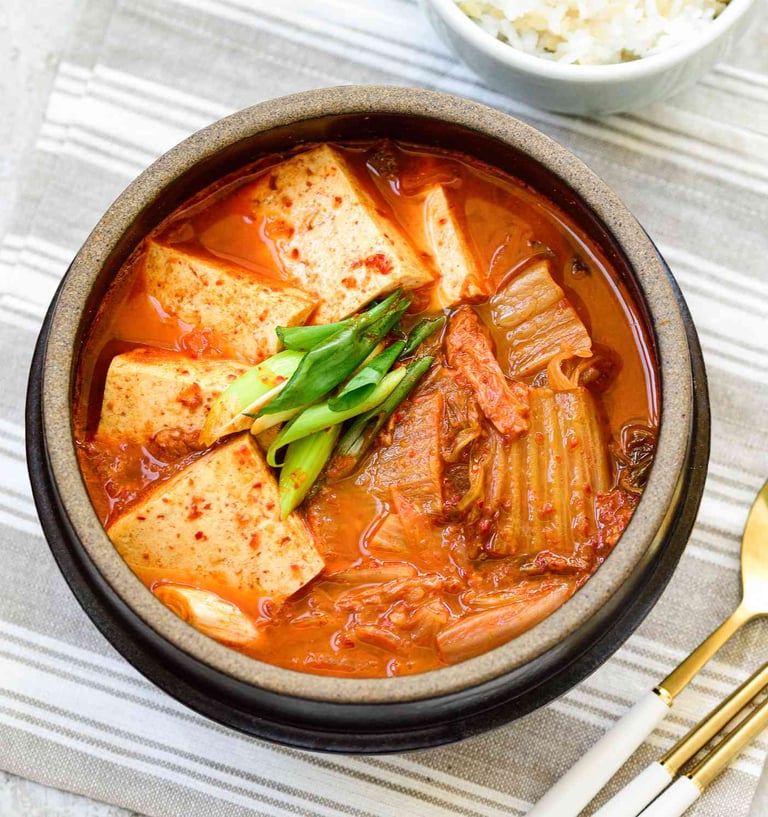

Kimchi Jjigae (Kimchi Stew)
Spicy stew made with kimchi, tofu, pork, and vegetables, a winter favorite.
Where to try: Any gukbap or jjigae restaurant nationwide.
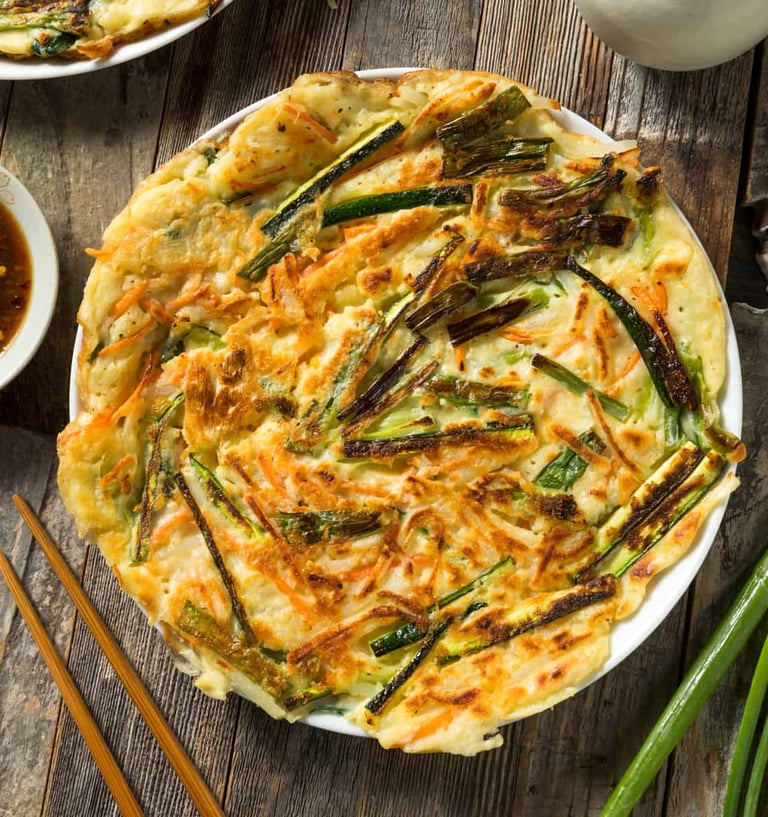

Pajeon (Green Onion Pancake)
Savory pancake with scallions, seafood, or kimchi, perfect with makgeolli.
Where to try: Traditional jeon houses in Jongno and at Gwangjang Market
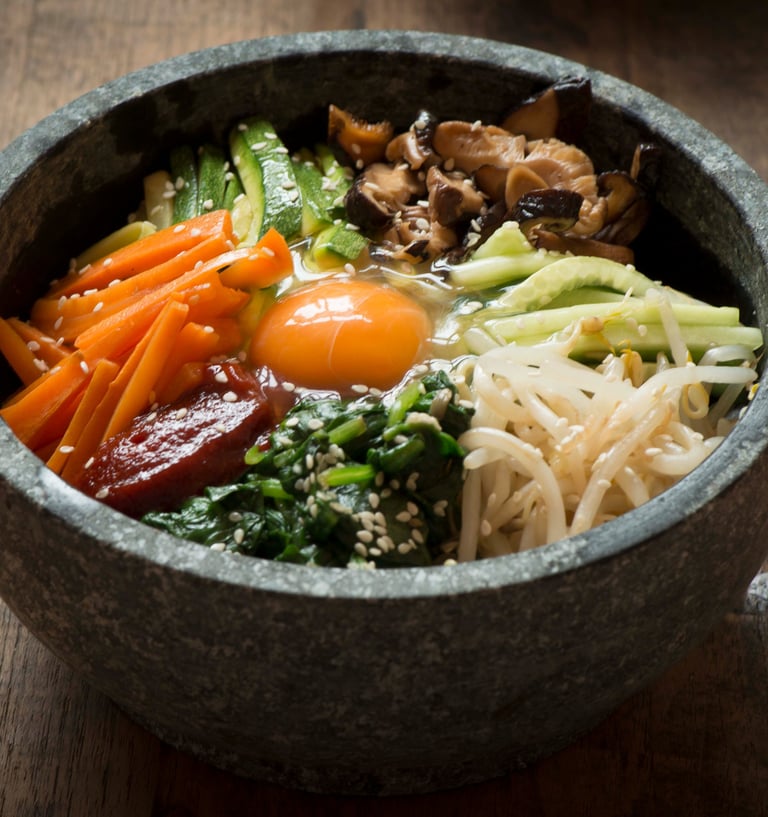

Bibimbap
One of Korea’s most famous dishes, is a colorful, balanced bowl of warm rice topped with an assortment of seasoned vegetables (namul), sliced beef, and a fried egg, served with spicy gochujang (red chili paste).
Where to try: Hankook Jib in Jeonju for the iconic Jeonju-style bibimbap or at Family House in Jeonju. Also at traditional Korean restaurants in Insadong, Seoul.
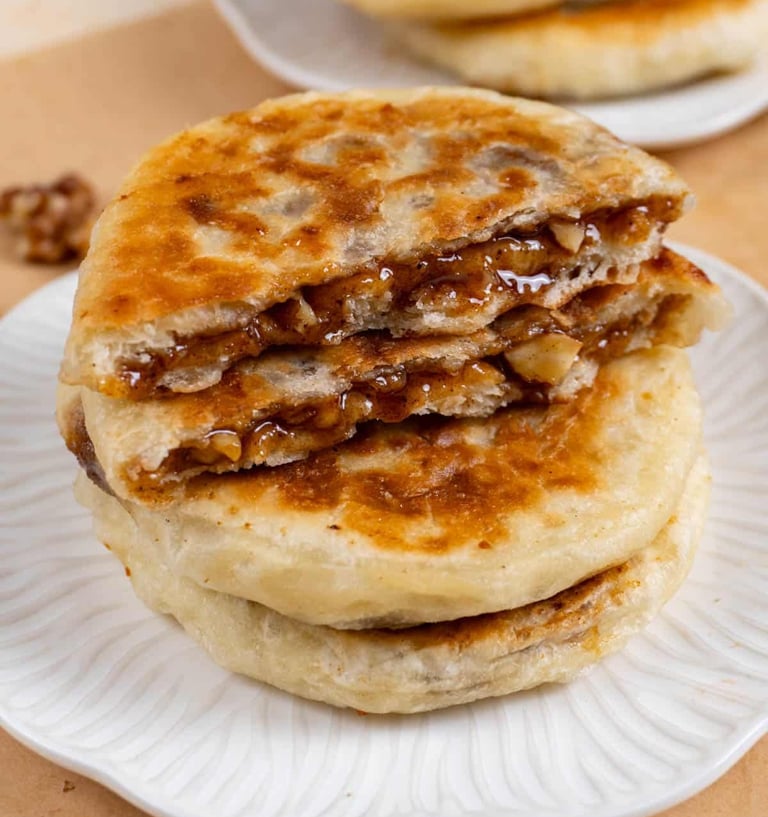

Hotteok (Sweet Pancake)
A pancake filled with sugar, cinnamon, and nuts, crispy on the outside, gooey on the inside.
Where to try it: At BIFF Square in Busan for the famous nut-filled version.
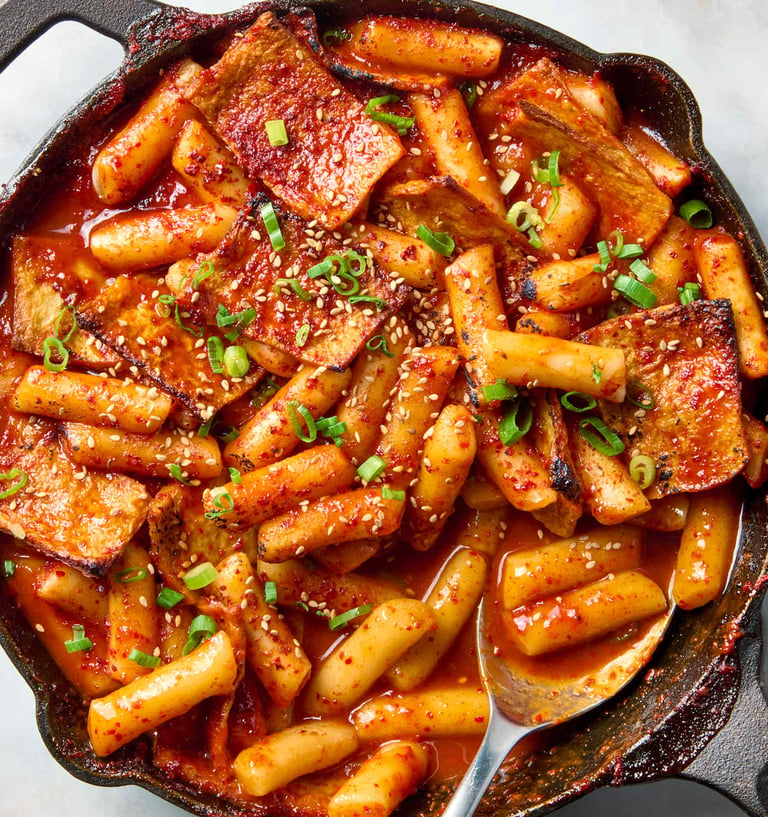

Tteokbokki
Chewy rice cakes simmered in a sweet spicy gochujang sauce. A street food classic that’s especially popular in the colder months.
Where to try: Myeongdong street stalls or at Euljjiro Soup Tteokbokki Myeongdong Branch.
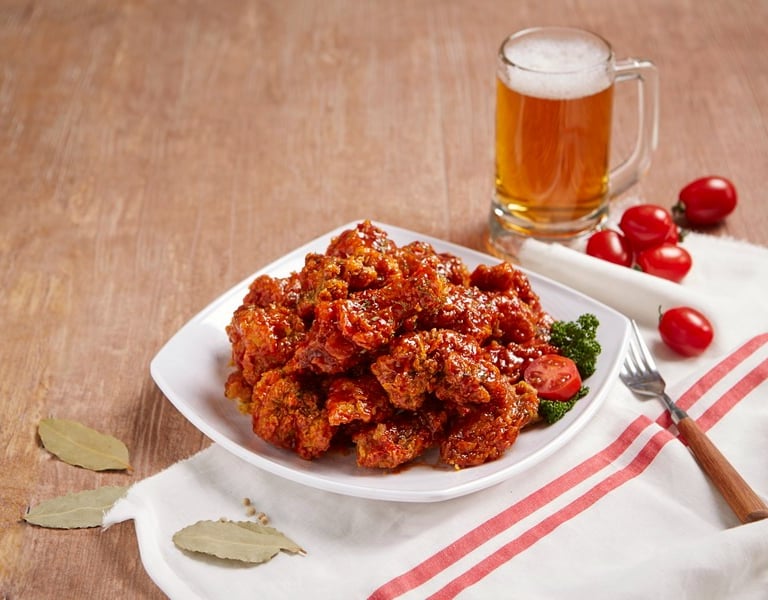

Chimaek
It is a popular Korean cultural phenomenon and culinary combination of fried chicken (chikin) and beer (maekju). The term itself is a synonym for the two words, and chimaek is enjoyed as anju (food consumed with alcohol) in South Korea.
Where to try it: at the famous “Beer & Chicken Street.”


Kimbap
Is a popular Korean dish consisting of seasoned rice, cooked fillings such as meat, fish, or vegetables, and dried seaweed (gim) rolled up and cut into bite-sized pieces. Unlike sushi, the rice in kimbap is seasoned with sesame oil, and the ingredients are usually cooked rather than raw.
Where to try it: At Gimbap Cheongu in Seoul
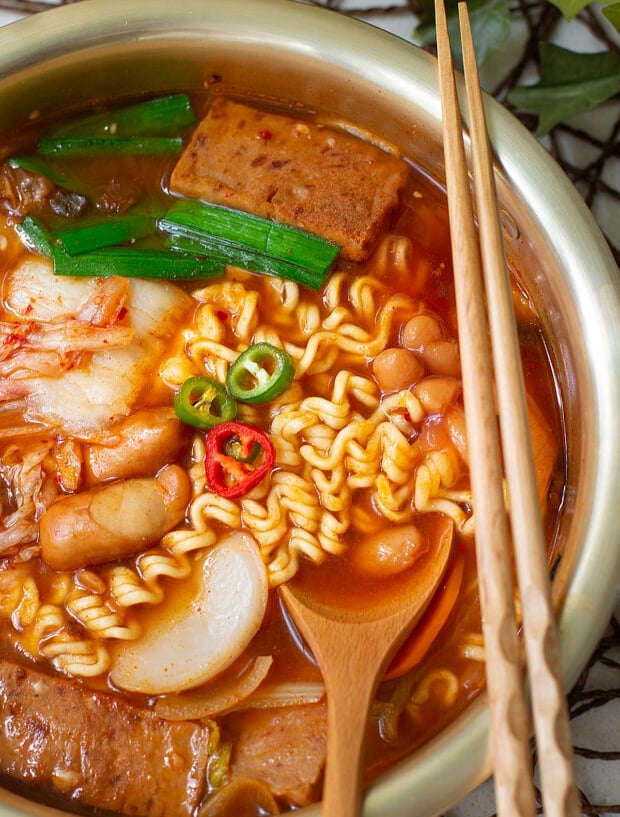

Ramyeon
Ramyeon is the Korean name for instant noodles, a popular, spicy, and quick food that is a staple of South Korean cuisine. Although inspired by Japanese ramen, ramyeon uses dried noodles that are often topped with additional ingredients such as eggs, scallions, kimchi, and vegetables.
Where to try it: At Yeouido Hangang Park
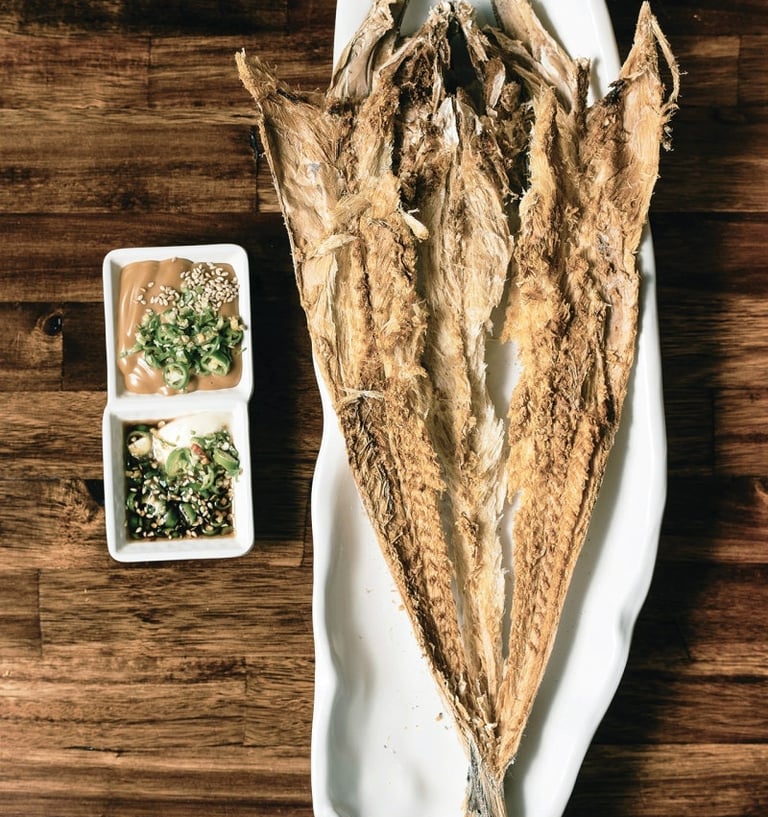

Nogari
It is dried cod and is grilled over a briquette fire and dipped in a red chili paste mixed with mayonnaise. Grilled dried cod goes well with beer and is commonly served at street snack stalls.
Where to try it: At the famous Nogari Alley in Euljiro, Seoul
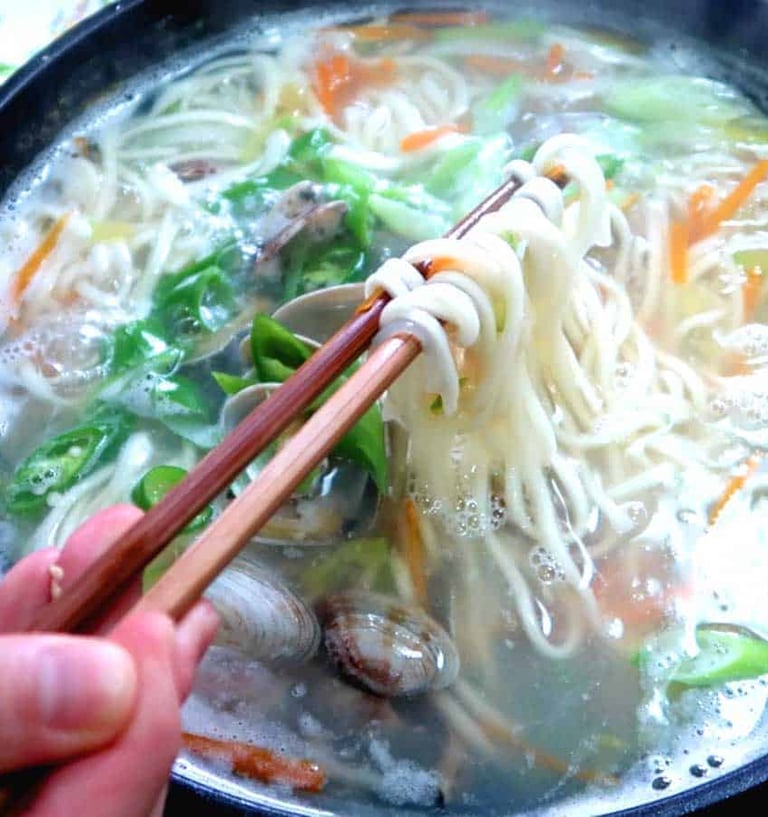

Kalguksu (Knife-Cut Noodles)
A comforting bowl of hand-cut wheat noodles served in a savory broth, often flavored with anchovies, chicken, or seafood.
Where to try: Myeongdong Kyoja in Seoul is legendary for its rich, garlic-laden broth and springy noodles. Also often found in traditional markets like Namdaemun or Gwangjang and at Veteran Kalguksu in Jeonju
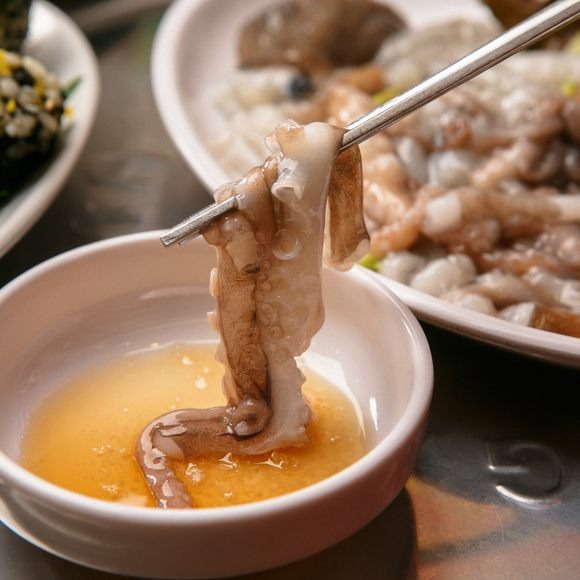

Sannakji (Live Octopus)
Not for the faint-hearted, sannakji is freshly chopped octopus served while still wriggling, seasoned with sesame oil and seeds. The key is to chew thoroughly to enjoy the tender texture and subtle ocean flavor.
Where to try: Jagalchi Market in Busan is the go-to.
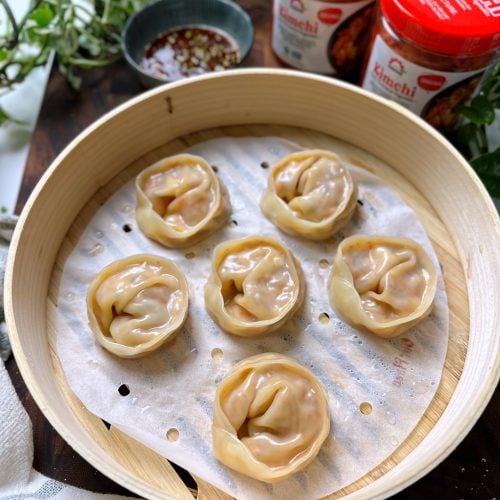

Mandu (Korean Dumplings)
Korean dumplings, steamed, boiled, or fried, filled with pork, vegetables, or kimchi.
Where to try: Traditional dumpling shops in Insadong or Myeongdong and at Myeongdong Kyoja in Seoul or and at Veteran Kalguksu in Jeonju
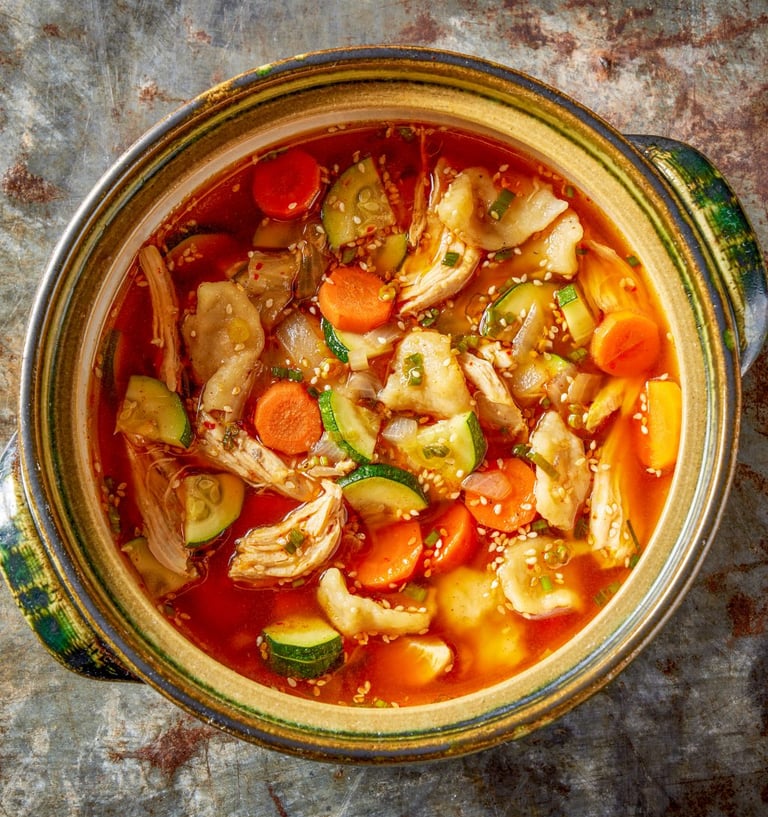

Sujebi (Hand-Torn Noodle Soup)
A rustic Korean comfort food where hand-torn wheat dough pieces are simmered in a rich broth, usually with potatoes, zucchini, and clams.
Where to try: Old-style noodle shops in Insadong or Bukchon Hanok Village, or at sujebi-specialty restaurants like Samcheongdong Sujebi in Seoul.
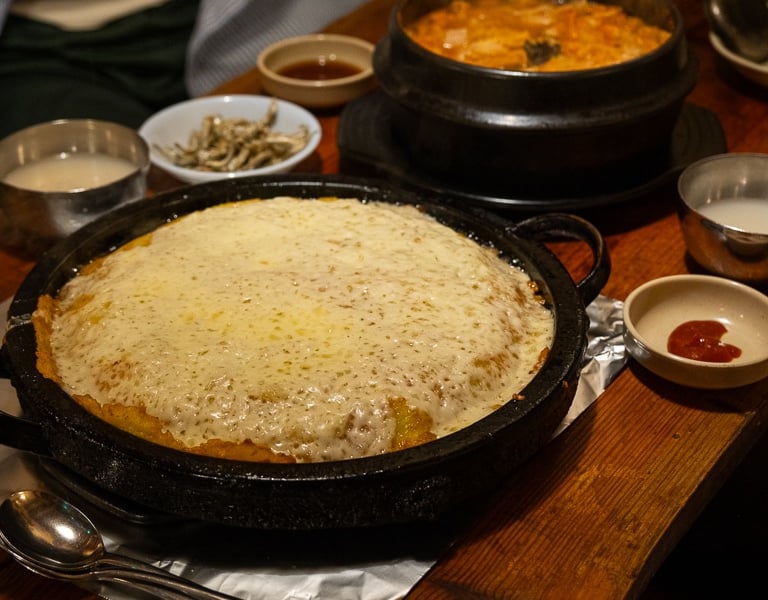

Yental Gamjajeon
A crispy, golden-brown pancake made entirely from grated potatoes, pan-fried until the outside is crunchy and the inside soft. The name comes from “Yeongtal,” a dialect term for large potatoes grown in the region.
Where to try: Sokcho and Chuncheon markets, or at Old-fashioned Potato Pancakes in Namyeong-dong
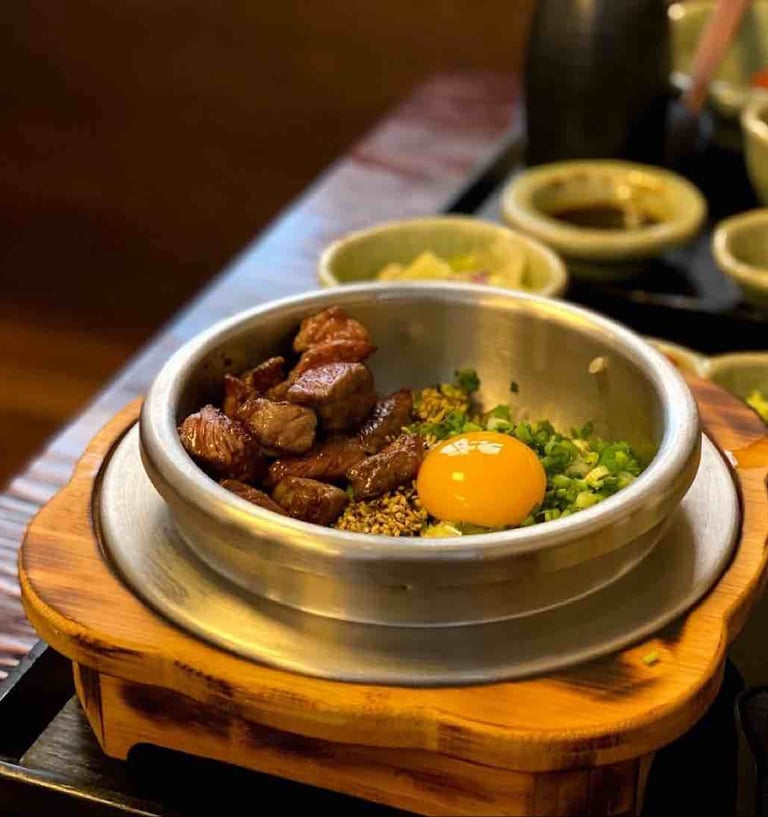

Steak Hot Pot Rice
A modern twist on traditional Korean stone pot rice (dolsot bap), it pairs juicy, medium-seared steak slices with rice, vegetables, and a savory soy-based sauce, all served in a sizzling hot stone bowl.
Where to try: Trendy fusion Korean restaurants in Seoul like Solsot Pot Rice House
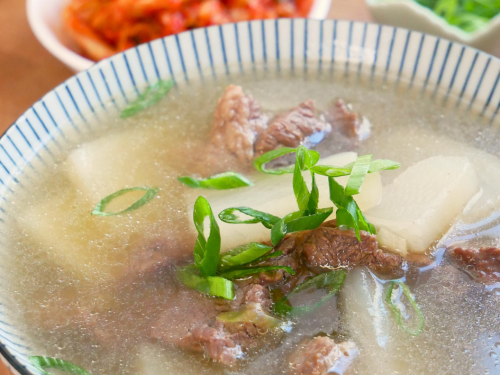

Radish Soup with Hanwoo Beef
A simple yet delicious Korean dish. The rich broth is slow-cooked with premium Korean beef and fresh radish. It is ideally accompanied with rice and kimchi for an authentically home-cooked meal.
Where to try it: At Nabokjip, a traditional hanok-style restaurant, where the warmth of hospitality meets the deliciousness of tradition.
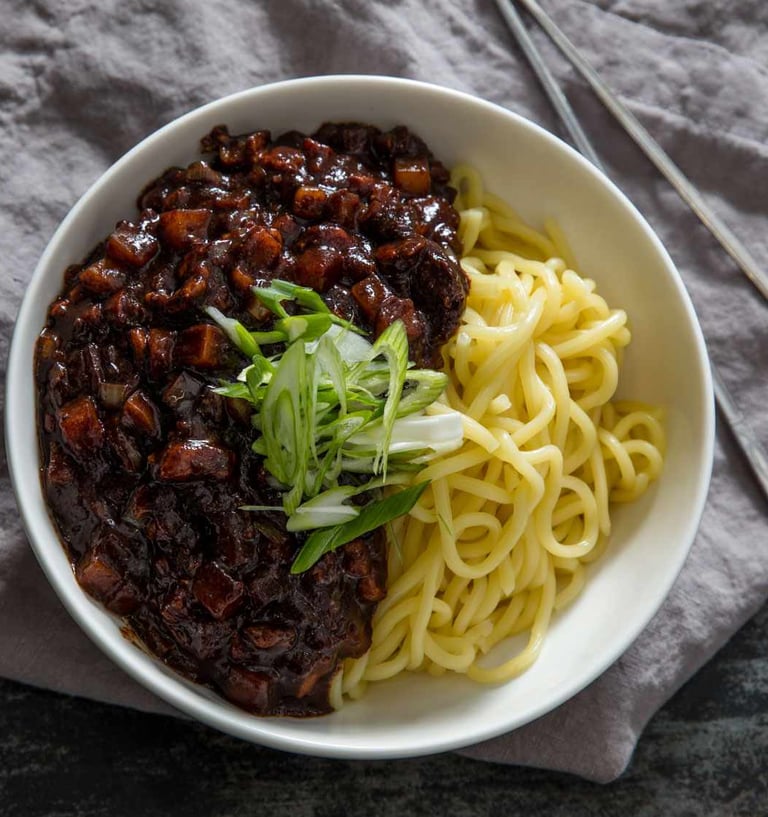

Jjajangmyeon
One of the most characteristic dishes of Korean cuisine with Chinese roots. Thick noodles dipped in a rich, black sauce made from chunjang beans, pork and vegetables.
Where to try it: At Mashi China or any small "Chinese-Korean" restaurant in the neighborhoods of Seoul, where jjajangmyeon has become almost a ritual.
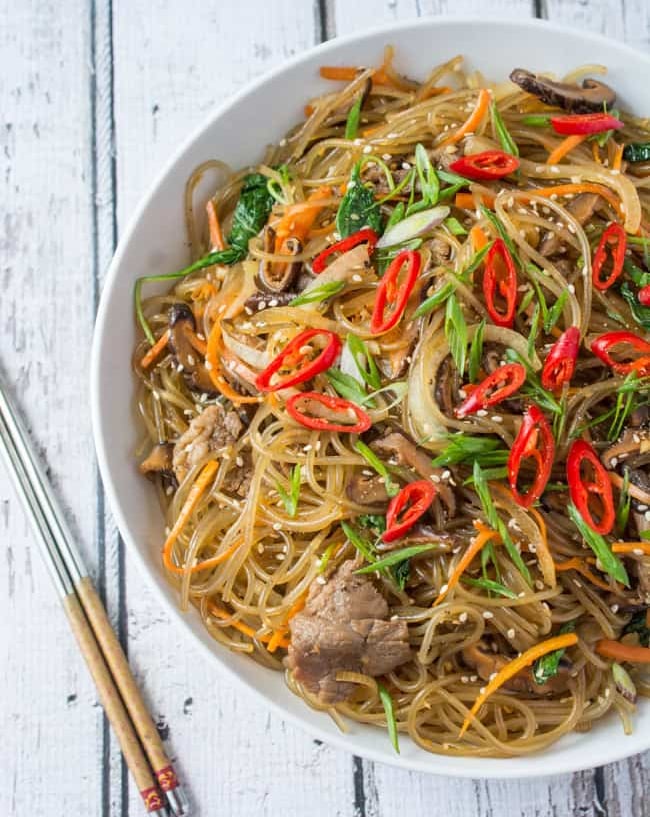

Japchae
A colorful dish of sweet potato glass noodles sautéed with vegetables, finely chopped beef, and a sweet-savory soy and sesame sauce.
Where to try it: At Wangbijip Myeongdong or a traditional Hanjeongsik restaurant for an authentic, homemade taste.
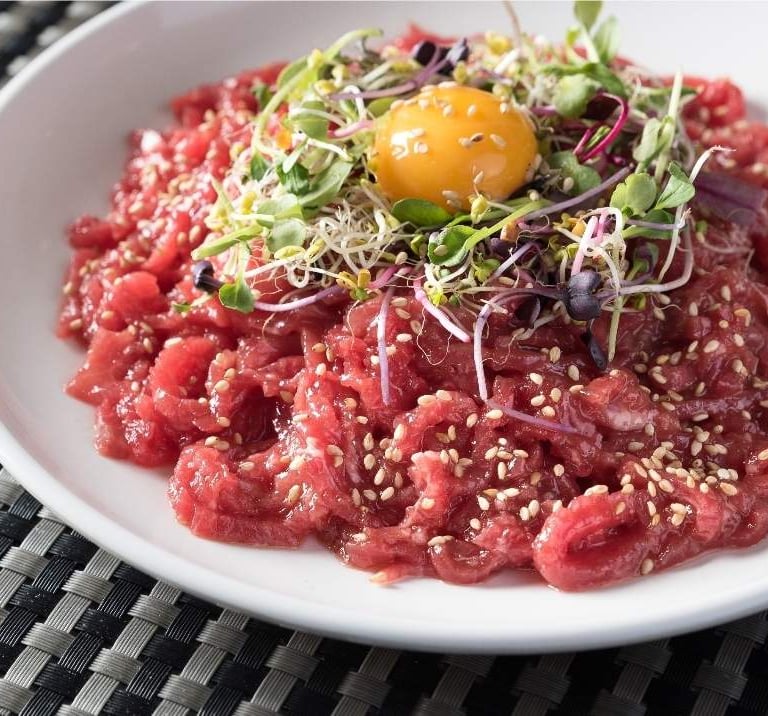

Yukhoe (Korean Steak Tartare)
Thinly sliced raw beef seasoned with soy sauce, sesame oil, pear slices, and egg yolk. It’s a luxurious dish often served in traditional Korean barbecue spots or specialized raw meat restaurants.
Where to try: High-quality BBQ restaurants or yukhoe-specialty shops. Specifically at Saebyeokjip Cheongdam-dong Branch in Gangnam.
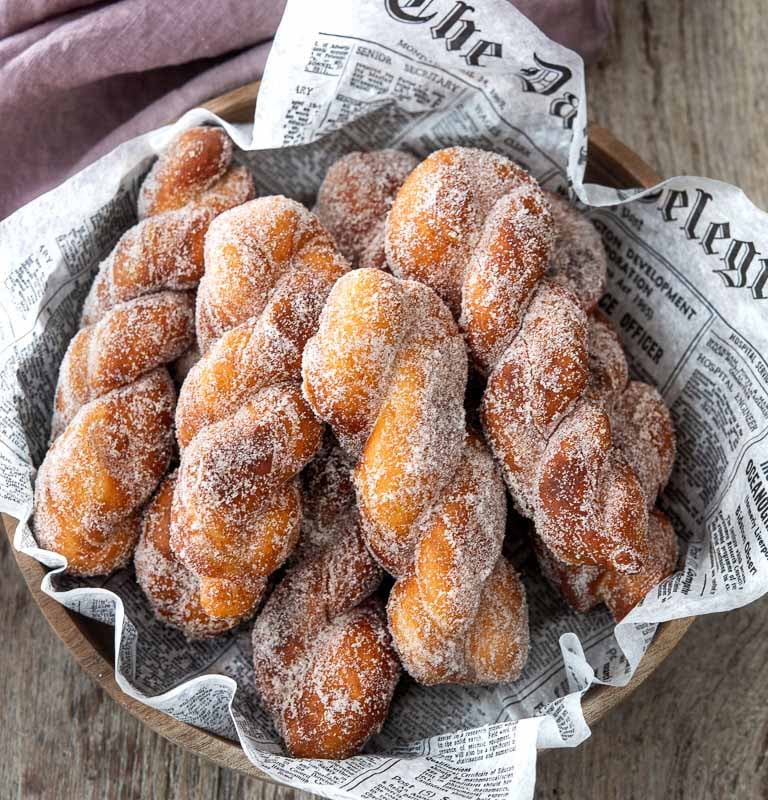

Kkwabaegi (Twisted Doughnut)
Twisted doughnuts dusted with sugar, light, fluffy, and nostalgic.
Where to try: Myeongdong and Namdaemun Market street vendors, there is also a great stall at Nowon Station Exit 5.
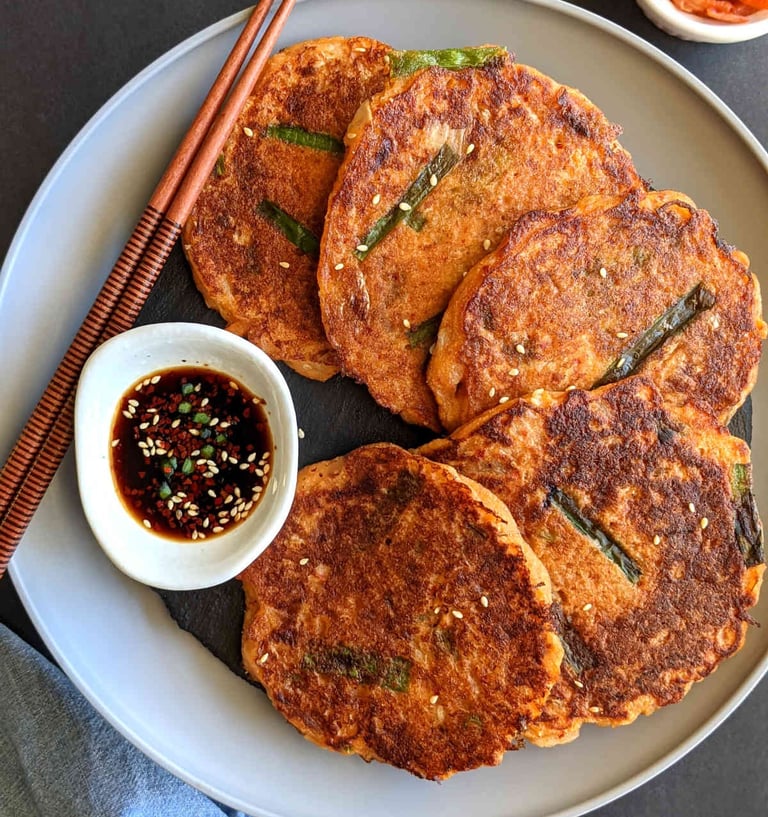

Bindaetteok (Mung Bean Pancake)
Savory pancake made from ground mung beans, vegetables, and pork, pan-fried until golden.
Where to try: Gwangjang Market’s food alley has sizzling griddles of bindaetteok ready to be devoured.
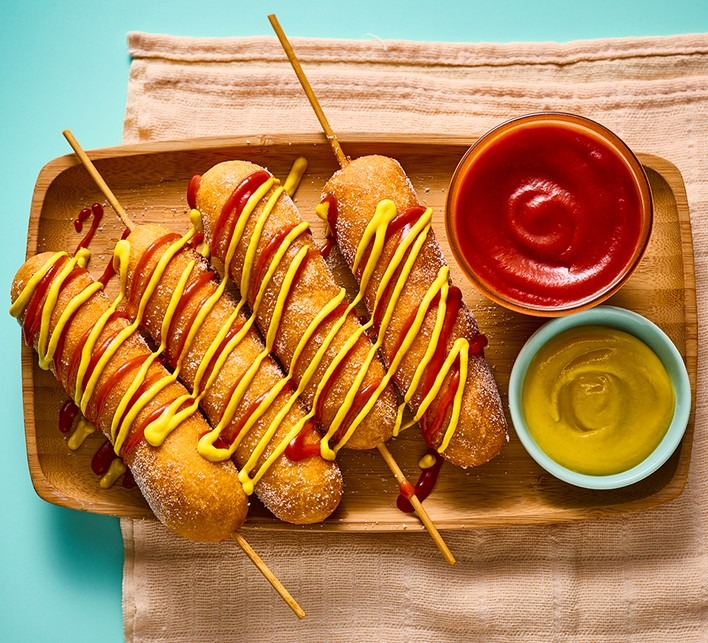

Corn Dog
The Korean corn dog is a playful and delicious street food take on the classic American snack. Golden and crispy on the outside, they hide sausage and/or melted cheese on the inside, while they are often sprinkled with sugar and topped with ketchup or mustard.
Where to try it: At the famous Myungrang Hotdog stands in Seoul or at any night street market.


Gilgeori Toast
One of the most characteristic breakfasts of Korean everyday life, gilgeori toast (street toast) combines egg, cabbage, carrot, sugar, ketchup and tomato sauce or mayonnaise between buttered slices of bread.
Where to try it: At Isaac Toast, the famous chain that made this simple street snack a global trend.
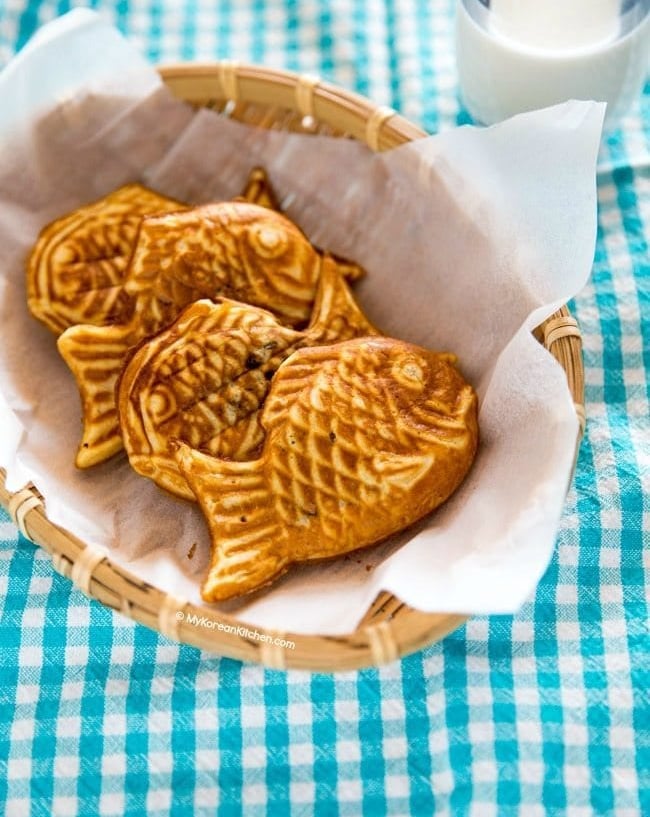

Bungeoppang
This fish-shaped dish doesn’t hide the sea, but… a sweet surprise! Bungeoppang is warm, crispy on the outside, and filled with sweet red bean paste on the inside. Sold at street stalls, it makes you feel like a kid with every bite.
Where to try it: From a street vendor at a winter street market or outside subway stations.
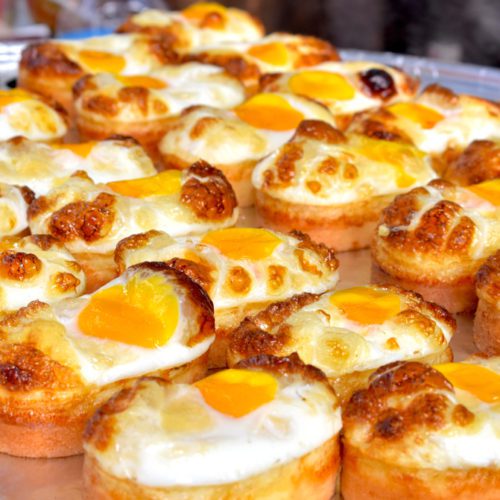

Gyeran-ppang
The “egg bun” is a small, fluffy delicacy that smells of butter and is baked in special molds. Inside each gyeran-ppang is a whole egg, creating a unique combination of savory and sweet. Perfect for a snack on the go or as comfort food on cold days.
Where to try it: At Myeongdong Street Food Alley, where its aroma fills the air.
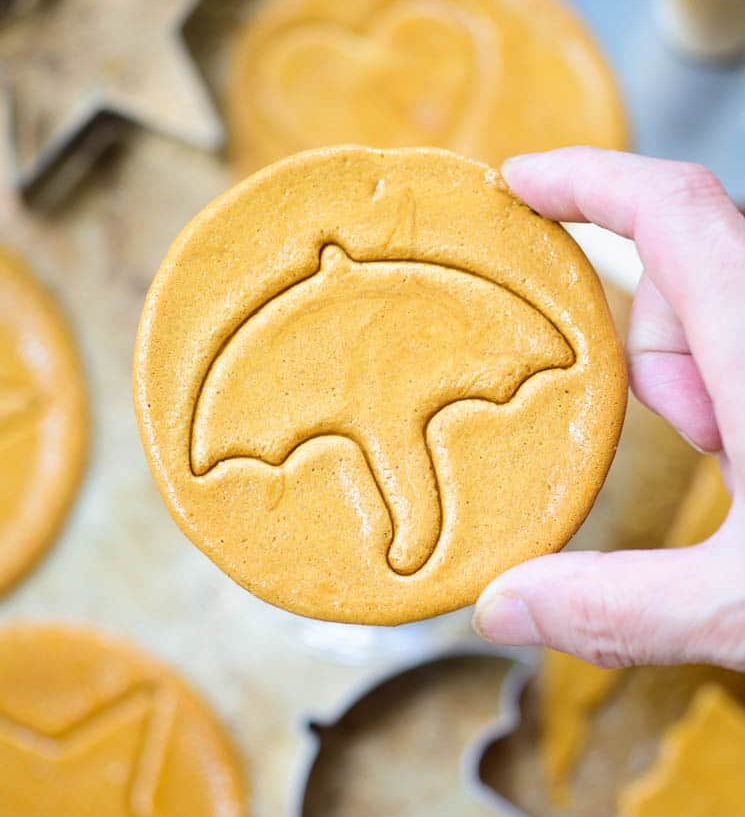

Dalgona
Dalgona is the ultimate Korean childhood nostalgia, a candy made from sugar and baking soda. It’s often shaped like a star or heart, and the “game” is to eat it without breaking the pattern. It’s been revived internationally through the Squid Game.
Where to try it: From street vendors around schools or tourist spots in Seoul.
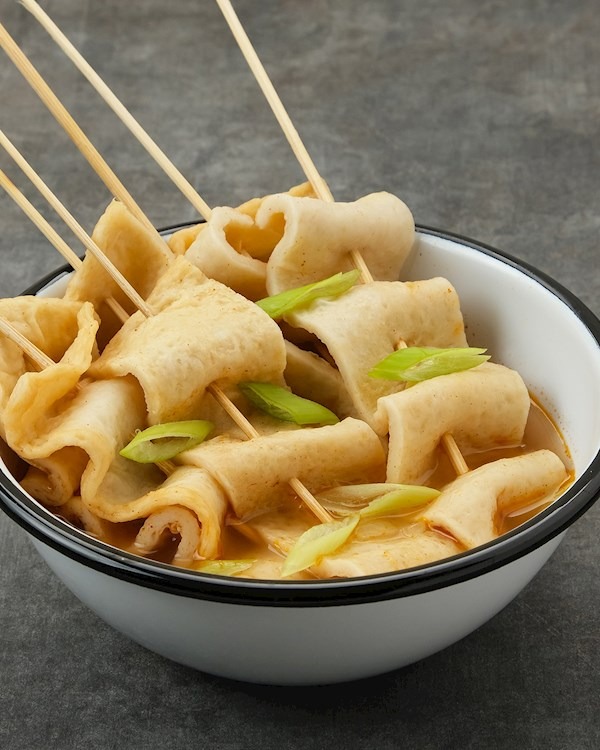

Eomuk (Fish Cake)
One of Korea's most popular winter snacks, eomuk are soft fish rolls in broth, served on sticks. Their warm, aromatic broth is usually served on the side.
Where to try it: At the street food stalls of Namdaemun Market or next to any stall that also serves tteokbokki.
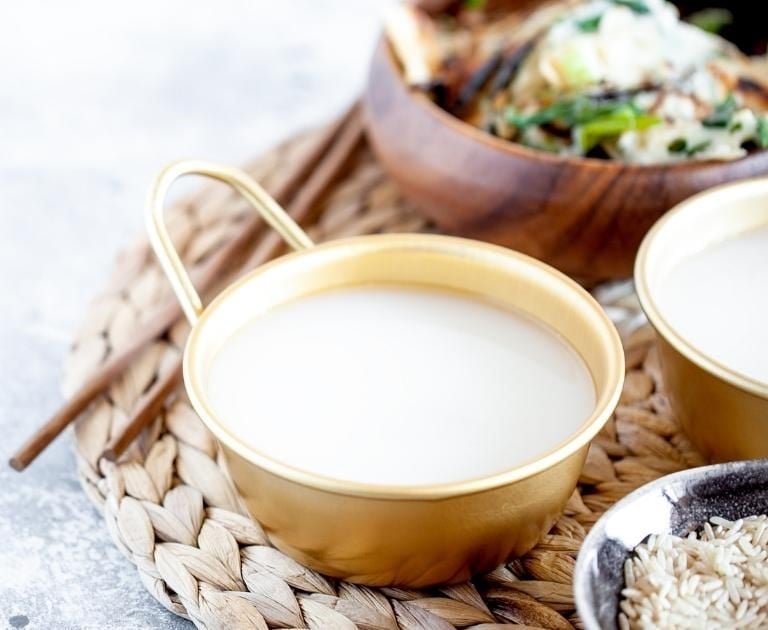

Makgeolli (Korean Rice Wine)
A cloudy, slightly sweet alcoholic drink made from fermented rice. Served in bowls and often paired with savory pancakes.
Where to drink: Local pajeon pubs in Jongno, Seoul and Rustic makgeolli houses in Seongsu-dong or Hongdae.

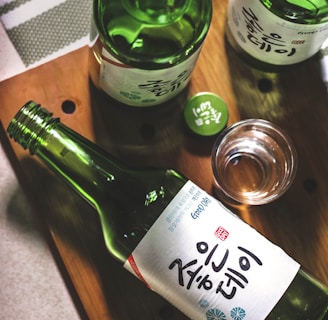
Soju
Korea’s iconic distilled liquor, smooth and perfect for pairing with BBQ.
Where to drink: Anywhere from street tents (pojangmacha) to upscale bars. Try flavored varieties for a modern twist.
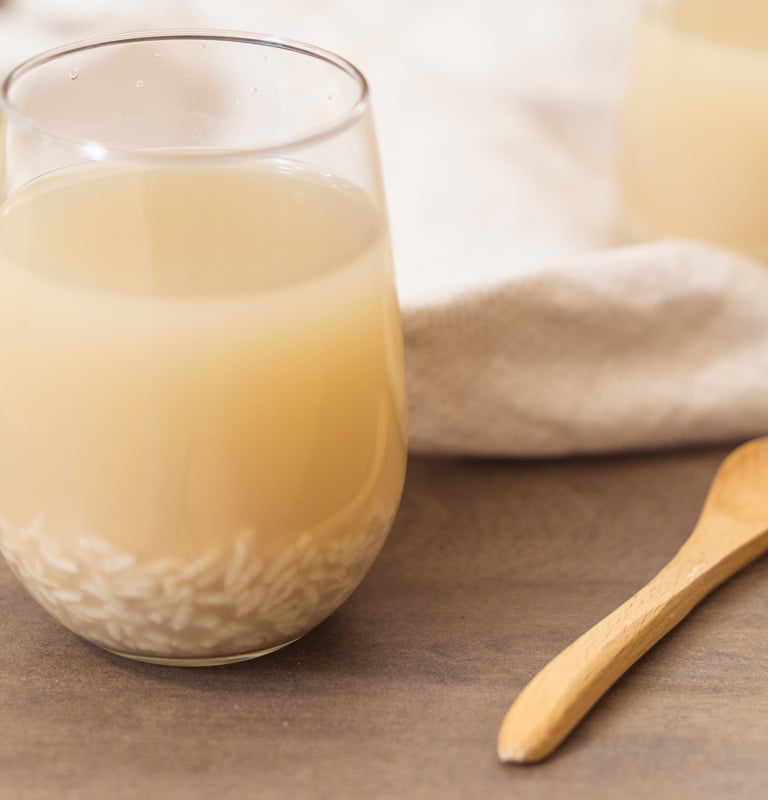

Sikhye (Sweet Rice Punch)
Sweet rice punch, traditionally served at festivals or after a hearty meal.
Where to try: Available at traditional Korean restaurants or bottled in convenience stores.
All places are mentioned in the map included in this post.
Beginner’s Guide to Korean BBQ
Korean BBQ (gogi-gui, literally “meat roast”) is more than a dining style, it’s a shared, sizzling feast where the grill is the centerpiece. From beef ribs (galbi) to marinated pork, Korean BBQ is an interactive feast. Whether you’re in a sleek city restaurant or a smoky, bustling local joint, the steps are similar. Here’s exactly how to navigate it like a local:
1. Choosing Your Meats
Most BBQ restaurants have a menu where you order portions of raw meat to grill yourself. Popular cuts include:
Samgyeopsal (삼겹살) – Thick, juicy pork belly slices.
Galbi (갈비) – Marinated beef short ribs, sweet and savory.
Chadolbaegi (차돌박이) – Paper-thin beef brisket, cooks in seconds.
Moksal (목살) – Pork neck, tender and flavorful.
Tip: If you’re unsure, ask for a mixed platter, you’ll get a variety to try.
2. The Sides (Banchan)
You’ll get a variety of small plates for free, and they’re refillable. Expect kimchi, pickled radish, seasoned spinach, bean sprouts, and sometimes mini pancakes (jeon). Ssamjang – A savory dip made of soybean paste and chili paste. Fresh garlic & chili peppers – Grill or eat raw with your wraps.
3. The Art of Grilling
Start with pork or beef depending on the cut, thinner meat cooks faster. Use tongs for turning meat and scissors to cut it into bite-sized pieces. Avoid over-flipping, let it develop that crispy sear.
4. How to Eat It (The Ssam Ritual)
Take a lettuce or perilla leaf. Add a piece of grilled meat. Top with grilled garlic, kimchi, ssamjang, or rice. Fold it into a little parcel and pop the whole thing into your mouth in one bite.
5. Drinks to Pair
Soju – The classic Korean distilled spirit.
Beer (Maekju) – Often mixed with soju to make so-maek.
Makgeolli – A slightly sweet, milky rice wine for a more traditional vibe.
6. Ending the Meal
After the meat, many locals order:
Bokkeumbap – Fried rice mixed with leftover meat and kimchi, cooked right on your grill.
Naengmyeon – Cold buckwheat noodles, refreshing after all that grilled goodness.
Where to try: Hongdae, Itaewon, and Euljiro in Seoul restaurants like Korean BBQ Backdon Euljiro or Jongsamyook or Mongtan or Jeju Rooftop Black BBQ or Wolhwa Sikdang. In Busan try Dasoni Korean BBQ or Jeju Daepae BBQ or Yakiniku gaek or 무쇠화로서면본점.
All places are mentioned in the map included in this post.


Hot Pot Dining in Korea – A Warm, Communal Feast
Korean hot pot dishes are more than just meals, they’re social experiences. Served in large, simmering pots at the center of the table, these broths bubble away while friends and family gather around, adding ingredients and serving themselves throughout the meal. The style has deep roots in Korea’s culinary tradition, blending fresh vegetables, seafood, meat, and noodles into slowly developing, richly flavored soups. Each hot pot has its own character: some are celebratory and refined, like jeongol, while others, like budae jjigae, tell a story of resilience and creativity. What they share is the warmth they bring, both in temperature and in the way they bring people together.
Jeongol (전골) – Korean Hot Pot at Your Table
Jeongol is the ultimate communal Korean dining experience, a beautiful, bubbling hot pot cooked right at your table. Traditionally enjoyed during gatherings or special occasions, it comes in a wide variety of styles: beef jeongol (suyuk jeongol) with tender slices of marinated meat, haemul jeongol with an abundance of seafood, or mandu jeongol featuring plump Korean dumplings. The broth starts mild but becomes richer as vegetables, mushrooms, tofu, and noodles slowly simmer. The joy of jeongol is in its pace, you cook, serve, and eat together, often chatting and topping up the pot with more ingredients as the meal goes on.
Where to try it: Look for restaurants with tabletop gas burners and large shallow pans, jeongol specialty restaurants are common in areas like Myeongdong and Hongdae in Seoul, or near traditional markets. A well known restaurant is Neungdong Minari Seongsu is well-known for its signature suyuk jeongol with boiled beef slices.
Budae Jjigae (부대찌개) – The “Army Stew”
Born out of necessity during the Korean War, Budae Jjigae, literally “Army Base Stew”, is a spicy, hearty hot pot that blends Korean flavors with surplus American army rations like spam, hot dogs, and baked beans. Over the years, it evolved into a beloved comfort food, especially on cold days. The fiery gochujang-based broth bubbles with instant noodles, tofu, kimchi, rice cakes, and assorted vegetables, creating a rich and savory dish that’s both nostalgic and indulgent. Diners cook it at the table, watching the ingredients meld into a deeply satisfying stew.
Where to try it: Many neighborhoods have casual budae jjigae joints, often serving it in big pots for sharing. Uijeongbu, north of Seoul, is considered the birthplace of the dish, but you’ll find excellent spots in Seoul’s Sinchon, Hongdae, and Gangnam areas.
Gopchang Jeongol (곱창전골)– Offal Hot Pot with Bold Flavors
Gopchang Jeongol is a rich, hearty hot pot made with beef or pork intestines (gopchang), simmered with vegetables, mushrooms, tofu, and often chewy noodles in a savory, slightly spicy broth. While gopchang may be an acquired taste for some, its popularity in Korea comes from its unique, slightly sweet flavor and pleasantly chewy texture. It’s considered an energy-boosting dish, and locals often pair it with a cold beer or soju for balance. Traditionally, it’s cooked right at the table, letting the flavors mingle and intensify as you eat. If you’re feeling adventurous, seek out a specialty gopchang restaurant, you’ll know you’ve found one by the mouthwatering aroma wafting out onto the street.


Bars in Korea You Have to Try
Korean food is only half of the experience, once the sun sets, the bar scene comes alive with creativity, flair, and flavors you won’t find anywhere else. Whether you’re into sleek speakeasies or cocktail bars pushing the boundaries of mixology, here are a few must-visit spots:
Bar Cham (Seoul) – Ranked among the 50 Best Bars in Asia, Bar Cham is an essential stop for cocktail lovers. Known for using traditional Korean ingredients in bold and playful ways, their drinks are an experience in themselves. Don’t miss the Gimbap Cocktail, a unique nod to Korea’s beloved street food wrapped in seaweed.
Zest Bar (Seoul) – A cozy and stylish space that blends modern mixology with light bites. Zest is the kind of place where the cocktails are refined but the atmosphere feels relaxed. Pair one of their signature drinks with small plates for a perfect pre-dinner stop or a nightcap.
Le Chamber (Seoul) – One of Seoul’s most famous speakeasies, Le Chamber is as much an adventure as it is a bar. To get in, you’ll have to find the right book on the bookcase, a hidden door opens to reveal an opulent lounge. Once inside, expect spectacular cocktail presentations, smoky effects, and drinks as elegant as the surroundings.
The Storage Room (Seoul)– A hidden gem disguised behind a cheese and meat shop. Once you slip past the front, you’ll find yourself in a cozy speakeasy with expertly mixed cocktails.
Jean Frigo (Seoul)– Perhaps one of the quirkiest entries, you enter through a fruit shop, but only if you open the right fridge door. Inside awaits a playful yet elegant bar with a creative drinks menu.
Corner Stone (Busan) – A sleek cocktail bar in Busan where presentation meets bold flavors, perfect for a refined night out.
Bar Case (Busan) – Known for its moody, intimate vibe and expert mixology, this Busan favorite is great if you want something low-key yet sophisticated.
All places are mentioned in the map included in this post.


Cafés & Bakeries in Korea: A Sweet Escape
Beyond sizzling BBQ and bubbling stews, Korea has carved out a reputation for its café and bakery culture. In fact, Seoul is often considered one of the café capitals of the world, where coffee meets design, desserts meet art, and every neighborhood seems to have its own hidden gem. Visiting cafés in Korea isn’t just about grabbing a latte, it’s an experience, from beautifully plated desserts to stunning architecture and themed spaces.
Here are some must-visit cafés and bakeries:
Seongsu Cafe Rafre Fruit (Seoul) – Known for its stunning fresh fruit cakes and light, elegant pastries. The Seongsu area itself is a hotspot for trendy cafés, making this a perfect stop for dessert lovers.
Cafe Onion Anguk (Seoul) – Famous for its old hanok-style building and its iconic dome-shaped pandoro pastries dusted with powdered sugar. A true fusion of tradition and modern café culture.
Osulloc Tea House Bukchon (Seoul) – A must for matcha and green tea lovers. Osulloc specializes in Jeju-grown tea and offers beautifully crafted desserts infused with earthy green tea flavors.
Cheongsudang Bakery (Seoul) – A high-end bakery known for its intricate breads, cakes, and delicate pastries that look almost too pretty to eat.
Passion5 (Seoul) – Not just a café but a dessert wonderland. Expect artistic pastries, chocolates, and cakes that combine French technique with Korean creativity.
Lick Sip (Seoul) – A small but stylish café, best known for its minimalist vibes and rich soft serve ice creams paired with coffee.
Lilion (Seoul) – Elegant and modern, this bakery café is a hidden gem for delicate cakes and light bites, perfect for an afternoon indulgence.
Mirukku Coffee (Seoul) – Beloved for its retro, minimalist vibe and top-notch hand-drip coffee. This spot is a favorite among coffee purists who want expertly brewed drinks in a calm, stylish setting.
Ireuri Cafe (Jeonju) – A cozy and artsy cafe that feels like a hidden retreat in Jeonju Hanok Village. It’s popular for its calm atmosphere and minimalist design.
Manchu Cafe (Jeonju) – One of Jeonju’s most beloved spots, offering delicious coffee in a stylish space surrounded by traditional charm. Perfect for relaxing after exploring the hanok village.
Nadam (Busan) – This hanok-inspired cafe is a hidden gem. With its peaceful courtyard, wooden interiors, and traditional-meets-modern vibe, it’s a perfect place to relax with a warm drink listening to classical music after exploring Busan’s bustling streets.
Caffeinated (Busan) – A trendy spot in Busan known for its specialty coffee and relaxed, modern vibe. Perfect for digital nomads or anyone wanting a laid-back afternoon break.
All places are mentioned in the map included in this post.
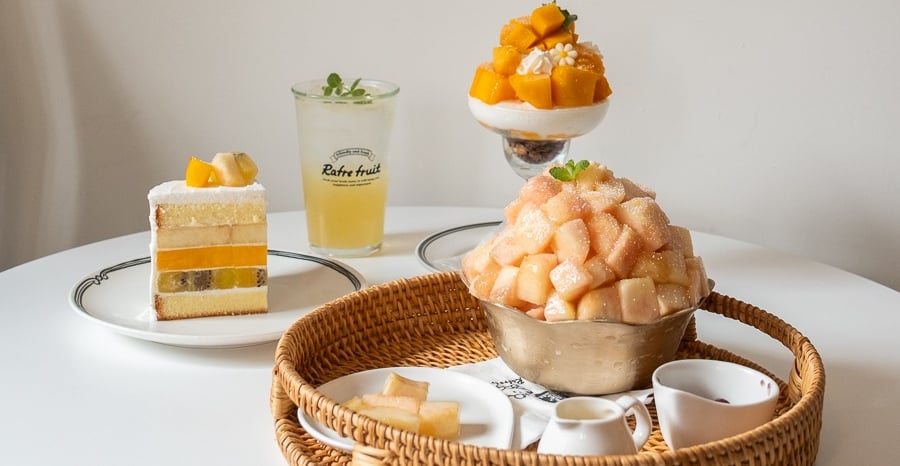

International Cuisine in Korea: Beyond Korean Flavors
While Korean food is unforgettable, the country also has a thriving international dining scene. In Seoul and Busan especially, you’ll find a mix of trendy eateries and authentic international restaurants, perfect if you’re craving something a little different after days of kimchi and BBQ.
Here are some must-try spots:
Elder Burgers (Seoul) – A cult-favorite burger joint where the patties are juicy, the buns perfectly toasted, and the toppings stacked just right. It’s a go-to for locals and expats who crave a classic American-style burger with a Korean twist.
Bunjiro (Seoul) – Specializing in Japanese cuisine, Bunjiro is particularly famous for its katsu sets, crispy, golden-fried cutlets served with rice, soup, and all the trimmings. It’s authentic, hearty, and absolutely satisfying.
Korea’s international dining scene doesn’t stop there—you can find everything from Italian trattorias to French patisseries, Middle Eastern eateries, and even authentic Mexican taquerias. The country’s cosmopolitan food culture means that whatever you’re craving, there’s probably a well-crafted version waiting for you. All places are mentioned in the map included in this post.


Fast Food in South Korea: Global Chains with a Korean Twist
Fast food in South Korea is a world of its own, a blend of global names and uniquely Korean creations. International chains like McDonald’s, Burger King, KFC, and Subway are everywhere, especially in big cities like Seoul and Busan, but they rarely serve the same menus you’d find back home. Instead, they adapt to local tastes with items like bulgogi burgers, shrimp burgers, or even fried chicken coated in spicy gochujang sauce. A McDonald’s combo meal costs around ₩6,000–₩8,000, making it a mid-range option compared to local street food.
But Korea also has its own fast food giants. Chains like Lotteria (Korea’s answer to McDonald’s) and Mom’s Touch specialize in fried chicken burgers and Korean-inspired sides. Kyochon, BBQ Olive Chicken, and BHC have turned fried chicken into an art form, often served with beer in the famous “chimaek” (chicken + maekju/beer) pairing. Delivery is a big part of fast food culture, Koreans can order burgers, fried chicken, or pizza through apps like Baemin, Coupang Eats, or Yogiyo, with meals arriving at your door in record speed, sometimes even with reusable plates and cutlery.
Pizza is another favorite, but it’s not what most foreigners expect. Local chains like Mr. Pizza, Pizza School, and Domino’s Korea offer toppings such as sweet potato mousse, bulgogi beef, corn, and even shrimp. Fast food in Korea is both familiar and surprising: it satisfies a craving for something quick while also showing off the country’s knack for taking global trends and giving them a local, flavorful twist.


Traveler Tips
Download Naver Map or KakaoMap (Google Maps doesn’t work well for directions).
Learn dish names in Korean for easier ordering, locals love when visitors try speaking the language.
Many markets are cash-friendly, but restaurants almost always take cards.


Korean cuisine is more than just food, it’s a reflection of the country’s soul, history, and hospitality. From sizzling BBQ platters shared with friends to humble bowls of noodles in bustling markets, each dish tells a story. Whether you stick to familiar flavors or dive into adventurous bites like live octopus, the experience will be unforgettable. With this guide in hand, you’re ready to taste Korea one bite at a time.
Drop us a comment bellow
Check our other post for South Korea
A Culinary Journey Through Korea – History, Iconic Dishes & Where to Eat Them
Korean cuisine has been shaped by centuries of history, geography, and tradition. Rooted in the country’s agrarian past, its food culture emphasizes seasonal ingredients, fermentation techniques, and balance between flavors. The famous Korean bapsang (table setting) tradition, with multiple small side dishes (banchan), dates back to the Joseon Dynasty, reflecting both royal elegance and everyday nourishment. Over time, Korean food has evolved, absorbing influences from trade, colonization, and globalization, yet it has fiercely preserved its identity. Today, it’s a vibrant mix of ancient recipes and modern innovations, from humble market stalls to high end fusion restaurants.
Evi
8/15/202517 min read
